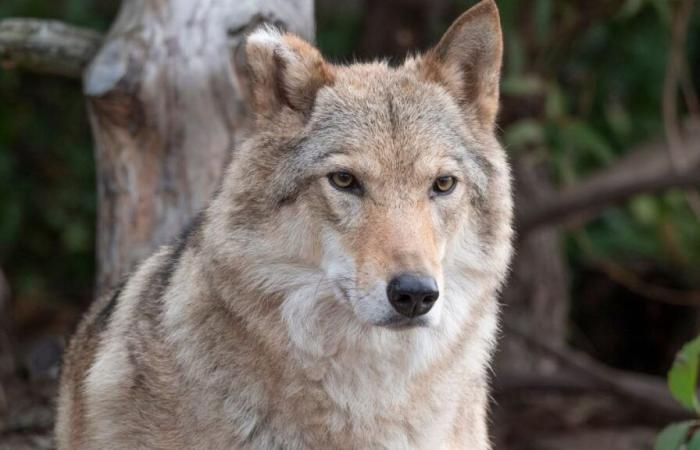
Wolves have made an impressive comeback in Europe in recent decades, but their presence is angering some farmers.
ADVERTISEMENT
This week, the European Commission will decide whether or not to limit the legal protection of the European gray wolf.
If this decision is taken, it would constitute a further step towards the legalization of the slaughter or hunting of these animals.
Farmers widely support the proposal, as does European Commission President Ursula von der Leyen, whose own pony, Dolly, was killed by a wolf in 2022.
However, environmental protection associations denounce the lack of scientific evidence that would support this text.
“The EU proposal to reduce gray wolf protection across Europe is based on a single, non-peer-reviewed report contracted by the European Commission, and which lacks independently verified data,” estimates the Green Impact association, in a press release.
Hundreds of researchers have signed two scientific declarations on the conservation of wolves and their role in restoring ecosystems.
Why has this issue become so controversial, and will humans ever be able to peacefully coexist with wolves in Europe?
The return of the gray wolf to Europe raises concerns
Typically, the return of a species once threatened with extinction is cause for celebration, but in this case, that's not the case.
The wolf has become a controversial subject in Europe. Environmental defenders praise its virtues and its environmental impact. Farmers, meanwhile, worry about their livestock in areas where wolves have not been present for decades.
Man brought wolves to the brink of extinction in the last century
In Europe, wolves have roamed the continent for centuries.
But as they sometimes attack livestock, they came into conflict with man, who began to chase away intensively. This led to their extinction in many European countries by the mid-20th century, although stable populations remained in some areas.
Since the 1970s, attitudes toward wolves began to change, and conservation efforts were made to revive declining populations. Today, according to a report from the European Large Carnivore Initiative, the number of wolves in the European Union has increased to around 19,000, and wolves now live in all continental member states of the Union.
This comeback is reflected in the list of threatened species of the International Union for Conservation of Nature, which now classifies the wolf in Europe in the category of species of least concern.
Ce spectacular return has been praised by many ecologists and conservationists, who cite the benefits of wolves for ecosystems.
“Large predators, especially top predators, are one of our best allies in the fight against climate change, deforestation and biodiversity loss,” says Enrique Perez, president of the European Alliance for Wolf Conservation (EAWC). This platform of national NGOs from 15 countries advocates for more rigorous application of wolf protection measures.
“So we shouldn't feel like this is a conflict or a problem, when it's quite the opposite.”
What are the difficulties encountered by Europe with the return of wolves?
But for some breeders, the return of wolf Europe is seen as a problem. Many have not had to deal with their presence for decades, if ever, and adjusting to them can be difficult and stressful.
Fears relate in particular to the loss of livestock. According to government statistics, more than 11,000 sheep and goats were killed in France in 2020. Farmers are financially compensated for their losses, but some believe this is not enough and does not solve the problem upstream.
Wolf defenders believe that the solution consists of installing electric fences, guard dogs and a human presence, but there is no consensus on this vision.
“These measures are simply insufficient,” says Niall Curley, senior policy adviser at Copa-Cogeca, the European Union farmers' association.
“Because of the large numbers of large carnivores that are coming in, they're just not effective and can actually inhibit the biodiversity or restoration of those habitats, particularly if you put up these big fences to try to keep wolves from enter, they also keep deer out.”
Niall Curley says he is in favor of changing the status linked to the protection of wolves at EU level, in order to allow “appropriate management” of populations.
On Tuesday, it will be decided whether or not to downgrade the status of the wolf from “strictly protected” to “protected”, under the Berne Convention.
Which would allow the EU to modify its directive “Habitats” in order to relax the protection of the species which, under current rules, can only be culled in certain circumstances, for example in cases of risk to public health or if the species has reached a favorable conservation status in an area.
The directive came into force in 1992 and is the cornerstone of EU biodiversity policy.
Wolves are illegally hunted across Europe
In Sweden, authorities gave the green light for hunters to kill 75 wolves out of an estimated total population of 460 last year.
“The wolf issue has become a symbol of the conflict between cities and rural areas,” said Johanna Sandahl, president of the Swedish Society for Nature Conservation.
This feeling is also noticeable in other European countries. At the end of April last year, the Bavarian government adopted a decree allowing hunters to kill several wolves in the event of an attack on livestock. Previously, only the affected wolf could be killed, but now multiple wolves can be targeted.
“The wolf has no place here,” Bavarian Minister President Markus Soeder told reporters. His party, the Christian Social Union (CSU), has called for the eradication of the animal in the country.
In response, conservationists accused him and his party of exploiting rural people's concerns about wolves.
Wolves are decapitated and poisoned in Europe
Enrique Perez of EAWC cites Spain as another example where the wolf subject is politicized.
Regional and local elections will take place at the end of the month, and general elections at the end of the year. He notes that “every four years (the Spanish electoral cycle), the wolf debate comes back”, before calming down again.
Three weeks ago, two wolf heads were placed on the steps of the town hall in Ponga, northwest Spain.
Since 2021, tensions between breeders and the Spanish government continue to grow. The country has strengthened legal protection for wolves by banning hunting everywhere except in exceptional circumstances.
This measure was criticized by breeders and local authorities in Castile and Leon, Galicia, Asturias and Cantabria, regions where 95% of Spain's wolves live.
Before the divisive measure was passed, wolves were protected in areas where they were fewer in number, but in areas where they were more numerous, they could be targeted by hunters subject to certain regulations.
In Italynine wolves were found poisoned last year, according to one of the country's national parks.
“The causes of the massacre have not yet been certified by the Istituto Zooprofilattico (Italian animal health authority),” the Abruzzo, Lazio and Molise park said in a statement at the time.
But the discovery in recent days of mouthfuls soaked in chemical substances leaves little doubt.
The debate over the cohabitation of large predators and humans in Italy was reignited after a bear killed a jogger in the Trentino region, in the north of the country, in 2023.
What happened to Ursula von der Leyen's pony?
European Commission President Ursula von der Leyen is one of the supporters of the EU proposal to weaken protection for wolves.
She herself had run-ins with these animals. Her pony Dolly, aged 30, was killed by a wolf near Hannover, Germany, in September 2022. The culprit was identified through DNA testing, and a shooting license was granted.
This permit has since lapsed and a spokesperson for the Hannover administrative court told Euronews: “As far as we know, the wolf should still be alive.”
Can wolves and humans coexist in Europe?
Hanna Pettersson is a social scientist and postdoctoral researcher at the University of York. She conducted field research in rural communities in northern Spain, to study the dynamics between the community, expanding wolf populations and authorities.
“One of the problems here that has really heightened the conflict is that laws and solutions tend to be imposed by central power,” she explains.
“They are proposed by people who don’t even live with these carnivores and who have no idea what is happening on the ground.”
Ms Pettersson believes that the solutions proposed are often too simplistic for such a complex issue. She wants us to become more involved with farmers themselves and that the authorities work with them to find different solutions for different communities, based on their needs.
“One solution would consist of making the wolf a vector of redistribution and rural development,” she suggests.
“Because what's happened for hundreds of years is a strong marginalization of rural areas and livelihoods. And that's the cause of a lot of the land abandonment that we're seeing Today”.
Mr. Pettersson adds that this is about addressing the vulnerabilities of rural areas that have to deal with wolves.
“For a large number of pet owners to accept the presence of a large carnivore in their neighborhood, it is first necessary to accept this great threat to sociocultural identity,” explains Glenn Lelieveld.
“If you agreed to this, and if you are supported by the government with additional staff, additional pay, additional equipment and training on how to do this, then over time the conflict could die down completely.”





